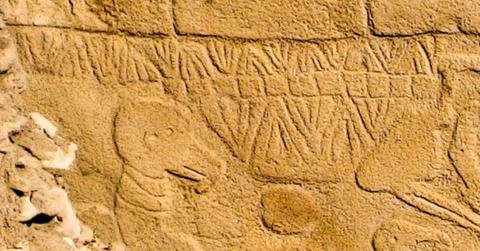12,000-Year-Old Carvings in Turkey May Reveal First Major Catastrophic Cosmic Event That Shaped Humanity

Carvings at Göbekli Tepe are thought to represent the world’s oldest calendar.
Carvings on a pillar at a 12,000-year-old monument in southern Turkey likely represent the world's first solar calendar, and possibly the first lunisolar calendar, according to a new study led by researchers at the University of Edinburgh in Scotland.
The carvings found at Göbekli Tepe, an ancient complex of temple-like structures in southern Turkey, could record a major cosmic event that changed the course of human civilization — a swarm of comet fragments that struck Earth in 10,850 B.C., nearly 13,000 years ago.
The comet strike is considered a possible source of a mini ice age that lasted some 1,200 years, potentially triggering lifestyle and agricultural changes believed to be linked to the dawn of civilization in the Fertile Crescent.
V-shaped symbols carved onto pillars at Göbekli Tepe appear to each represent a single day, allowing researchers to count a solar calendar of 365 days on one of the pillars, consisting of 12 lunar months plus 11 extra days.
The summer solstice appears to be marked by a special V worn around the neck of a "bird-like beast" that could represent the summer solstice constellation visible in the sky at the time. Nearby statues, possibly representing deities, have similar V markings on their necks.
Because the moon's cycles are also represented, researchers say it could be the world's first lunisolar calendar, predating other lunisolar calendars by thousands of years.
The carvings also appear to record the Taurid meteor stream emanating from Aquarius and Pisces, which is believed to be the source of the fallen comet fragments.
Researchers say the markings appear to show that the ancient people at the site knew how to record dates using precession, or the wobble of the Earth's axis that changes the apparent locations of the constellations in the sky. If so, it would predate the first known documentation of the phenomenon Hipparchus of Ancient Greece in 150 B.C. by some 10,000 years.
- What Lies Beneath: NASA Scientist Believes Aliens May Have Found 'Perfect' Hiding Spot in Earth's Oceans
- Global Threat: Russia Insider Warns West of 'World War Using Nuclear Weapons' Amid Escalating Support for Ukraine
- Countdown to Disaster? Ex-NATO Official Warns Russia, Iran and China Could Wage WWIII in Just Years
Because of the importance of the Göbekli Tepe site for millennia, researchers say the comet impact event recorded there may have "triggered a new cult or religion that influenced the development of civilization."
“It appears the inhabitants of Göbekli Tepe were keen observers of the sky, which is to be expected given their world had been devastated by a comet strike," Martin Sweatman of the University of Edinburgh’s School of Engineering, who led the research, said in a statement.
Never miss a story — sign up for the Front Page Detectives newsletter. Be on the scene the moment news breaks.
"This event might have triggered civilization by initiating a new religion and by motivating developments in agriculture to cope with the cold climate. Possibly, their attempts to record what they saw are the first steps towards the development of writing millennia later," Sweatman said.
The new study is published in the journal Time and Mind.
TMX contributed to this report.
Become a Front Page Detective
Sign up to receive breaking
Front Page Detectives
news and exclusive investigations.
